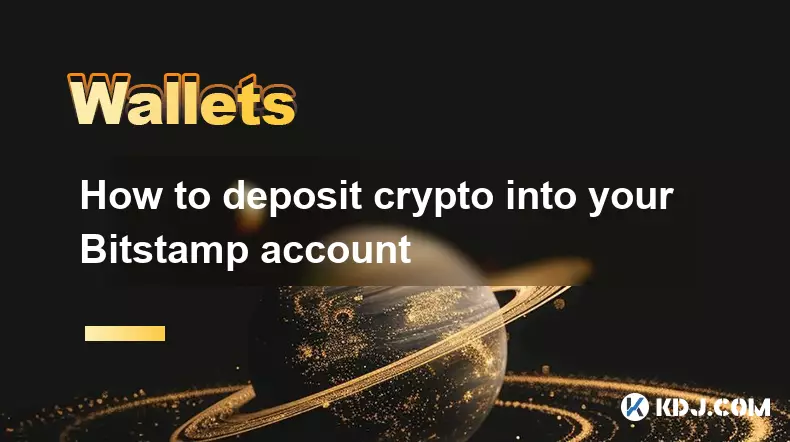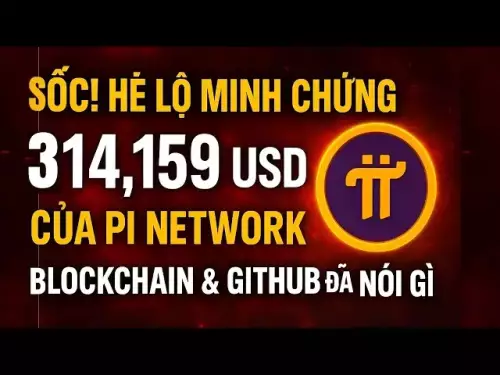-
 bitcoin
bitcoin $109547.008142 USD
0.04% -
 ethereum
ethereum $4011.838726 USD
-0.05% -
 tether
tether $1.000402 USD
-0.01% -
 xrp
xrp $2.798606 USD
0.88% -
 bnb
bnb $970.877944 USD
1.39% -
 solana
solana $202.237275 USD
-0.95% -
 usd-coin
usd-coin $0.999673 USD
0.00% -
 dogecoin
dogecoin $0.229294 USD
-1.15% -
 tron
tron $0.336370 USD
-0.45% -
 cardano
cardano $0.777260 USD
-1.66% -
 hyperliquid
hyperliquid $45.503019 USD
1.73% -
 ethena-usde
ethena-usde $1.000362 USD
0.01% -
 chainlink
chainlink $20.785303 USD
-1.10% -
 avalanche
avalanche $28.755822 USD
-0.11% -
 stellar
stellar $0.358303 USD
-0.48%
How to deposit crypto into your Bitstamp account
To deposit crypto to Bitstamp, log in, select your asset, generate a unique address, and transfer from your wallet—ensuring network compatibility and double-checking details.
Sep 16, 2025 at 10:00 pm

How to Deposit Cryptocurrency into Your Bitstamp Account
Depositing cryptocurrency into your Bitstamp account is a straightforward process designed to ensure security and ease of use. The platform supports multiple digital assets, allowing users to transfer funds directly from external wallets or other exchanges. Understanding each step helps minimize errors and ensures that your assets arrive safely.
Accessing the Deposit Section
1. Log in to your verified Bitstamp account.Security measures require all users to complete identity verification before accessing deposit functions. Once logged in, navigate to the 'Deposit' section located in the main menu.
2. Select the cryptocurrency you wish to deposit.Bitstamp supports several cryptocurrencies such as Bitcoin (BTC), Ethereum (ETH), Litecoin (LTC), Ripple (XRP), and others. Choose the correct asset to receive the proper deposit address.
3. Confirm network compatibility for ERC-20 or BEP-20 tokens.If depositing Ethereum-based tokens, ensure the sending wallet uses the Ethereum network. Sending tokens via an incompatible network may result in permanent loss of funds.
4. Generate a unique deposit address.Bitstamp generates a new receiving address for each deposit to enhance security and transaction tracking. This address is specific to your account and the selected cryptocurrency.
5. Double-check all details before initiating the transfer.Verify the deposit address, amount, and network type on your sending wallet. Even minor discrepancies can lead to irreversible transactions.
Initiating the Transfer from External Wallets
1. Open your external wallet or exchange platform.This could be a hardware wallet like Ledger or Trezor, a software wallet such as MetaMask, or another exchange like Binance or Coinbase.
2. Begin a withdrawal operation using the Bitstamp deposit address.Paste the generated address carefully into the recipient field. Avoid copying from untrusted sources or screenshots susceptible to malware tampering.
3. Enter the amount you intend to transfer.Consider leaving a small buffer to cover potential network fees if transferring from a wallet that doesn’t auto-calculate them.
4. Set an appropriate transaction fee based on network congestion.Higher fees typically result in faster confirmation times, especially during peak usage periods on networks like Bitcoin or Ethereum.
5. Confirm and broadcast the transaction.After final review, approve the transfer through your wallet’s authentication method—PIN, seed phrase, or hardware button confirmation.
Monitoring the Deposit Status
1. Return to the Bitstamp dashboard after initiating the transfer.The platform automatically monitors incoming transactions linked to your deposit addresses.
2. Wait for blockchain confirmations.Different cryptocurrencies require varying numbers of confirmations before funds are credited. For example, Bitcoin usually requires three confirmations, while Ethereum may need twelve.
3. Check the transaction status under the 'Transactions' tab.Here, you can view real-time updates including pending, confirmed, or failed statuses. A successful deposit will reflect in your available balance once confirmed.
4. Contact support only if the transaction remains uncredited beyond expected timeframes.If more than 24 hours have passed without confirmation, gather the transaction ID (TXID) and contact Bitstamp customer service with full details.
5. Never reuse deposit addresses for enhanced privacy and security.Although some wallets allow repeated use, Bitstamp encourages generating new addresses per transaction to reduce exposure to potential threats.
Frequently Asked Questions
Does Bitstamp charge fees for crypto deposits?
No, Bitstamp does not charge any fees for receiving cryptocurrency into your account. However, you remain responsible for paying the network transaction fee imposed by the blockchain you are using.
Can I deposit stablecoins like USDT or USDC on Bitstamp?
Yes, Bitstamp supports select stablecoins such as Tether (USDT) on the Ethereum (ERC-20) and Tron (TRC-20) networks. Make sure to choose the correct network option when generating the deposit address to prevent fund loss.
What should I do if I sent crypto to the wrong address?
If you mistakenly send funds to an incorrect address, immediately check whether the transaction has been confirmed. If unconfirmed, there may be limited options depending on the wallet used. Once confirmed, recovery is generally not possible unless the recipient voluntarily returns the funds.
How long does it take for a crypto deposit to appear in my Bitstamp account?
Processing time depends on the selected cryptocurrency and current network congestion. Most deposits are detected within minutes, but full confirmation can take anywhere from 10 minutes (Litecoin) to over an hour (Bitcoin during high traffic). Ethereum-based tokens usually settle within 15–30 minutes under normal conditions.
Disclaimer:info@kdj.com
The information provided is not trading advice. kdj.com does not assume any responsibility for any investments made based on the information provided in this article. Cryptocurrencies are highly volatile and it is highly recommended that you invest with caution after thorough research!
If you believe that the content used on this website infringes your copyright, please contact us immediately (info@kdj.com) and we will delete it promptly.
- Whale Movements, XPL Token, and Hyperliquid: Decoding the Crypto Tides
- 2025-09-28 14:25:14
- BullZilla Roars: Presales, Ripple, and TRON in the Crypto Jungle
- 2025-09-28 14:25:14
- Nation-State Bitcoin Adoption: Samson Mow's Perspective on the 'Suddenly' Moment
- 2025-09-28 14:45:12
- XRP Price, WallStreetBets, and Rally Prediction: A New Era?
- 2025-09-28 14:45:12
- Pi Network, Sign Protocol, and the Binance Listing Buzz: What's the Deal?
- 2025-09-28 14:30:01
- BTC, HODLers, and a Potential Bull Run: A New Yorker's Take
- 2025-09-28 14:30:01
Related knowledge

How do I view smart contract interaction history in Coinbase Wallet?
Sep 24,2025 at 01:36am
Accessing Smart Contract Interaction History in Coinbase Wallet1. Open the Coinbase Wallet application on your mobile device and log in using your cre...

How do I use the token swap feature in Coinbase Wallet?
Sep 24,2025 at 05:00pm
Understanding Token Swaps in Coinbase Wallet1. The token swap feature in Coinbase Wallet enables users to exchange one cryptocurrency for another dire...

How do I participate in governance voting in Coinbase Wallet?
Sep 25,2025 at 01:55pm
Understanding Market Volatility in the Crypto Space1. Cryptocurrency markets are known for their extreme price fluctuations, often driven by sentiment...

How do I set up a custom RPC node in Coinbase Wallet?
Sep 24,2025 at 12:00pm
Understanding Custom RPC Nodes in Coinbase Wallet1. A custom RPC (Remote Procedure Call) node allows users to connect their Coinbase Wallet to a block...

How do I manage multiple assets in Coinbase Wallet?
Sep 23,2025 at 10:00am
Understanding Multi-Asset Support in Coinbase Wallet1. Coinbase Wallet allows users to store a wide variety of digital assets beyond just Bitcoin and ...

How do I connect Coinbase Wallet to a hardware wallet?
Sep 26,2025 at 02:54am
Connecting Coinbase Wallet to a Hardware Device1. Open the Coinbase Wallet app on your mobile device and ensure it is updated to the latest version. N...

How do I view smart contract interaction history in Coinbase Wallet?
Sep 24,2025 at 01:36am
Accessing Smart Contract Interaction History in Coinbase Wallet1. Open the Coinbase Wallet application on your mobile device and log in using your cre...

How do I use the token swap feature in Coinbase Wallet?
Sep 24,2025 at 05:00pm
Understanding Token Swaps in Coinbase Wallet1. The token swap feature in Coinbase Wallet enables users to exchange one cryptocurrency for another dire...

How do I participate in governance voting in Coinbase Wallet?
Sep 25,2025 at 01:55pm
Understanding Market Volatility in the Crypto Space1. Cryptocurrency markets are known for their extreme price fluctuations, often driven by sentiment...

How do I set up a custom RPC node in Coinbase Wallet?
Sep 24,2025 at 12:00pm
Understanding Custom RPC Nodes in Coinbase Wallet1. A custom RPC (Remote Procedure Call) node allows users to connect their Coinbase Wallet to a block...

How do I manage multiple assets in Coinbase Wallet?
Sep 23,2025 at 10:00am
Understanding Multi-Asset Support in Coinbase Wallet1. Coinbase Wallet allows users to store a wide variety of digital assets beyond just Bitcoin and ...

How do I connect Coinbase Wallet to a hardware wallet?
Sep 26,2025 at 02:54am
Connecting Coinbase Wallet to a Hardware Device1. Open the Coinbase Wallet app on your mobile device and ensure it is updated to the latest version. N...
See all articles










































































